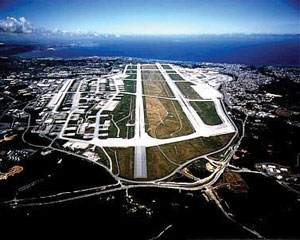
MV-22 Protests Latest in History of Okinawan Unrest
Roughly 30-50,000 people gathered in a park in Ginowan on September 9th calling for the removal of the MV-22 Osprey aircraft, decrying them mechanically unsafe and dangerous to operate around the urban Futenma air station. This has been the largest demonstration against US military presence in Okinawa in several years, underlining the growing political significance of the US-Japan alliance as the US pivots to the Pacific. However, these recent protests over US deployment of the airplane-helicopter hybrid are just the latest in a long history of local discontent over US basing in Japan.
Following the end of WWII, all of Japan was placed under US control. In 1952, it regained its independence while still supporting the majority of US operations in the Pacific with upwards of 80 US-controlled bases throughout the country. The island of Okinawa in particular held a very high concentration of the troops and bases.
Recent figures show that about 25% of all United States Forces Japan facilities and 50% of all US military personnel are located on Okinawa. In contrast, Okinawa represents only 1% of Japan’s total land mass. This disparity has led some Okinawans to perceive themselves as victims of both Japanese and US domination, owing in some part to their distinctive cultural and political views from Tokyo.
Protests over bases in Okinawa have erupted periodically since their foundation- part of the long-standing controversy over US basing. Notably, large protests formed in 1995 and 2004 following incidents involving a rape and a helicopter crash, respectively. Despite bringing significant economic opportunity to the island, residents’ complaints are varied and persistent. Okinawans in the past several decades have raised concerns over personal safety, noise levels, crime, environmental degradation and the militarization of the island.
In 2006, the George W. Bush Administration and the Tokyo government agreed to relocate the Marine Corps Air Station in Futenma to a different part of Okinawa as part of a larger realignment of bases in Japan. This would have shifted around 8,000 US Marines to Guam and returned land rights to the local government in addition to addressing the safety and noise concerns of residents in the surrounding area. However, other interests object to the relocation of the air station. In particular, those that benefit economically from the base, including employment and patronage opportunities, have been very vocal against the agreement. Additionally, because of potential harm to local endangered species, environmentalists have rejected the proposed location for the new air station.
The Futenma air station issue has since been taken up by a number of Japanese politicians, most notably Prime Minister Yukio Hatoyama who pledged in his campaign to finally resolve the basing conflict on Okinawa by removing Futenma and transferring its functions off the island. By May of 2010, negotiations had once again stalled, causing Hatoyama to effectively reverse his position on the Futenma air station and later resign in failure.
As the Obama Administration announced the US strategic pivot to the Pacific at the beginning of this year, the dispute over the US presence Okinawa still had not been resolved. Unfortunately, progress that was made in negotiations around April also corresponded with the deployment of the MV-22s to Futenma and a new round of protests.
Despite many Okinawans supporting the stronger US-Japan alliance that resulted from the strategic pivot, they continue to feel that the island has been subjected to a significant and disproportionate burden. The protests over the Osprey aircraft highlight a further break with Tokyo policies on this decisive issue of US basing.
As Japan struggles to maintain its regional power, the US-Japan alliance becomes even more of a high stakes game. While unlikely that the Okinawan protests will affect this long-standing security arrangement, it could put greater pressure on an already unstable government in Tokyo. Both sides wish to reach a solution before further straining the US-Japan alliance and allowing other regional powers to gain strategic advantage.






[…] MV-22 Protests Latest in History of Okinawan Unrest […]